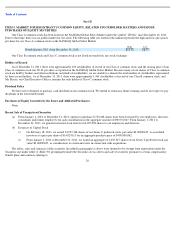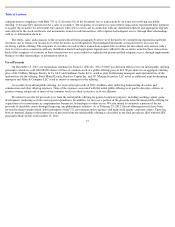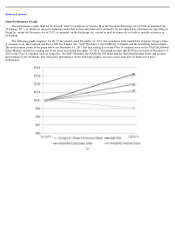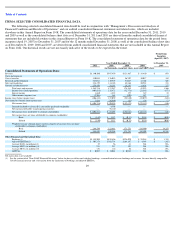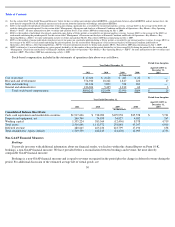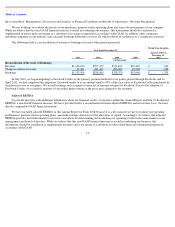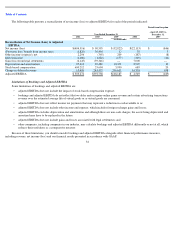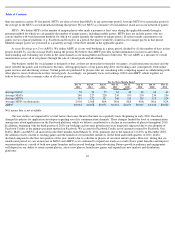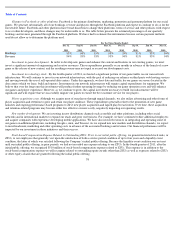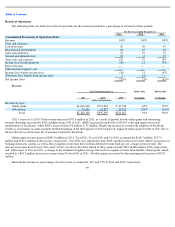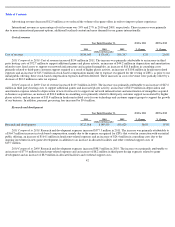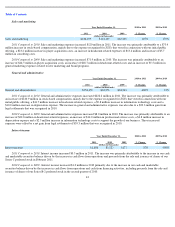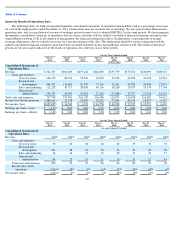Zynga 2011 Annual Report Download - page 39
Download and view the complete annual report
Please find page 39 of the 2011 Zynga annual report below. You can navigate through the pages in the report by either clicking on the pages listed below, or by using the keyword search tool below to find specific information within the annual report.
Table of Contents
Key Metrics
We regularly review a number of metrics, including the following key metrics, to evaluate our business, measure our performance, identify
trends in our business, prepare financial projections and make strategic decisions.
Key Financial Metrics
Bookings. Bookings is a non-GAAP financial measure that is equal to revenue recognized during the period in addition to the change in
deferred revenue during the period. Bookings, as opposed to revenue, is the fundamental top-line metric we use to manage our business, as we
believe it is a better indicator of the sales activity in a given period. Over the long term, the factors impacting our bookings and revenue are the
same. However, in the short term, there are factors that may cause revenue to exceed or be less than bookings in any period.
Adjusted EBITDA. Adjusted EBITDA is a non-GAAP financial measure that we calculate as net income (loss), adjusted for (provision
for) / benefit from income taxes; other income (expense), net; interest income; gain (loss) from legal settlements; depreciation and amortization;
stock-based compensation and change in deferred revenue. We believe that adjusted EBITDA provides useful information to investors and
others in understanding and evaluating our operating results in the same manner as our management and board of directors. For a reconciliation
of net income (loss) to adjusted EBITDA, see the section titled “—Non-GAAP Financial Measures” Included in Item 6. Selected Consolidated
Financial Data of this Annual Report on Form 10-K.
Key Operating Metrics
We manage our business by tracking several operating metrics: “DAUs,” which measures daily active users of our games, “MAUs,”
which
measures monthly active users of our games, “MUUs,” which measures monthly unique users of our games, “MUPs,” which measure monthly
unique payers in our games, and “ABPU,” which measures our average daily bookings per average DAU, each of which is recorded by our
internal analytics systems.
DAUs . We define DAUs as the number of individuals who played one of our games during a particular day. Under this metric, an
individual who plays two different games on the same day is counted as two DAUs. Similarly, an individual who plays the same game on two
different platforms (e.g., web and mobile) or on two different social networks on the same day would be counted as two DAUs. Average DAUs
for a particular period is the average of the DAUs for each day during that period. We use DAU as a measure of audience engagement.
MAUs. We define MAUs as the number of individuals who played a particular game in the 30-day period ending with the measurement
date. Under this metric, an individual who plays two different games in the same 30-day period is counted as two MAUs. Similarly, an
individual who plays the same game on two different platforms (e.g., web and mobile) or on two different social networks in a 30-day period
would be counted as two MAUs. Average MAUs for a particular period is the average of the MAUs at each month-end during that period. We
use MAU as a measure of total game audience size.
MUUs. We define MUUs as the number of unique individuals who played any of our games on a particular platform in the 30-day period
ending with the measurement date. An individual who plays more than one of our games in a given 30-day period would be counted as a single
MUU. However, because we cannot always distinguish unique individuals playing across multiple platforms, an individual who plays any of our
games on two different platforms (e.g., web and mobile) in a given 30-
day period may be counted as two MUUs in the event that we do not have
data that allows us to de-duplicate the player. Because many of our players play more
35



